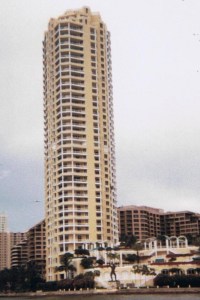Since they aren't piping Miami ICW into beaches anymore, our wonderful tour of the Port of Miami was lengthened by another mile and another 15 minutes. When we finally reached the mouth of the Miami River, we came to the feet of the skyscrapers in a housing complex. At the center of their waterfront was a sculpture. It looked like the Old Man of the Ocean, Neptune himself, saving the Earth from the brown soup of the Miami River! Saving us as the cans and bottles float on by and out to sea.
Turning south into the ICW, we motored toward the first of three bridges. We were in the center of the channel about 20’ out from the bridge when our depth gauge came back to life: “0.2’, 0.6!” I announced with excited relief. Whatever that safety margin was set to – we are definitely changing it to read real depth! If you are on Lake Michigan, an 18’ inch is a great margin. But in the Keys and the Bahamas every inch counts for us! And that is when I recalled the final words from the US Tow guy… “I’ll be standing by on Channel 16.” Looking at Spun Key I chuckle about the dollar signs we was dreaming of all along!
Not only do we have a deep draft, but our minimum clearance at high tide is listed as a rather tall 56’ Our first bridge was listed as 66’ (again per our old paper charts). And as we went under, neither Phil nor I could believe there was really another 10 feet above our weather vane. And the eyes of the fishermen at the bridge pilling seemed to also have been watching in awe… hoping for some action. Luckily we disappointed them.
3:30pm Biscayne Bay & Pass by Dinner Key
And so we enter Biscayne Bay from the north, on a dreary grey, Friday afternoon. Of course traffic along the bridge has picked-up as the rain is coming in. And the familiar cruiser’s lair, Dinner Key looked cold, wet and uninviting. Although just a few hours earlier, with visions of needing fuel line parts, we had images of staying at Dinner Key Friday night. But with the leak fixed and the view un-inviting, we chugged on past: Phil at the helm plucking his way through Friday afternoon ICW traffic; Cuka singing her rain song; and my eyes on the charts and depth gauge.
Now although there is only one official ICW path through Featherbed Bank, many of the locals prefer to take a little western branch (or ICW- A1A as I like to call these things – a play on the US Hwy 1’s beachy alternates). Because our charts were so dated, we planned to start “asking the locals” for actual depth once we got closer to the branch. It sounded simple – just hail a vessel coming toward us and ask them if they noticed the depth when they were coming thru. Yeah, sure! As I said, nobody seems to monitor their VHF anymore. Four boats and we were still clueless. And then the rain grew a bit heavier and the channel markers blurred. Poor weather, night falling and unsure course = anchor for the evening. And so, we set anchor just north east of Featherbed Bank off Elliott Key in Biscayne National Park.
Sunset N of Elliott Key
Although the rain only lasted until 6:30, the winds were steady all night. So the only motion working the boat was a steady breeze from the West. It was great to finally cook a real meal! It was a lot like backpacking. When you’re three days out from refrigeration and grocery stores almost anything tastes great. Phil’s macaroni and cheese was no exception! Even better was the canned pineapple for dessert.
But the best part was sipping warm Guinness and watching the sunset. The sun actually set over Turkey Point, Florida Power and Light’s nuclear power plant most vulnerable to a terroristic attack (imagine a little rocket launcher on a pontoon). But the sky’s show was not from the sun itself, but from the bright pink it shined into the windows of Downtown Miami. Ten miles to the north the skyline had been invisible through the rain at the time we anchored. But now, the sun setting in August was just north and west, so the pink light shot off the glass like a neon sign. But only for a few minutes. Soon the pink faded back to grey and the white lights started to freckle the towers.
Although the clouds stayed all night and blocked our show from the planets and shooting stars, we didn’t miss them. After 51 hours, we were finally stopped and able to shower and sleep!













